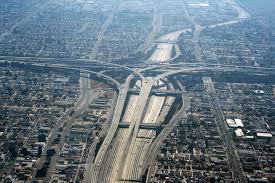Physical Address
304 North Cardinal St.
Dorchester Center, MA 02124
Physical Address
304 North Cardinal St.
Dorchester Center, MA 02124

HUD has released 2015 building permit tallies. Austin’s tallies for 2015: Single Family Units: 2,846 Duplex units: 326 Units in 3-4 unit buildings: 30 Units in 5+ unit buildings: 6,890 This bipolar split is typical of American cities. Some cities build more single-family than multi-family. Some build more multi-family than single-family. But the fourplex is dead. We build very little small-scale multi-family these days, which is why the “missing middle” is a focus of zoning code rewrites and a meme among the New Urbanist crowd. Although “missing middle” housing could easily be added to established single-family neighborhoods while preserving “neighborhood character,” it is mostly illegal in Austin and most other American cities, at least within the single-family districts, and it is often staunchly resisted by homeowners in older neighborhoods, where the form of housing makes most sense. Some homeowners, in fact, seem to dislike “missing middle” housing more than any other kind of housing. It is worth thinking about why. It is useful to first think about building technologies. After manufactured housing, the simplest, cheapest housing technology is the low-rise, wood-frame construction used in detached single-family homes. Small apartment buildings can be built using essentially the same techniques. Most large suburban apartment projects, in fact, are developed as a cluster of two-three story buildings containing 8-12 units each. These buildings would actually form nice low-rise, urban neighborhoods if they were arranged around a public street grid, but instead they are arranged around parking lots, private drives and landscaped common areas in garden-style developments. The next step up from low-rise, wood-frame technology is the mid-rise apartment building of four to seven stories. This type of development requires elevators (and thus a concrete elevator core) and usually consists of “stick and brick” construction over a concrete podium. It is at least twice as expensive per square foot as similar quality single-family housing — more if it includes structured […]

Suburbs have been around for as long as there have been urbs – cities, that is – a fact Robert Bruegmann reminds us of in his excellent book Sprawl. And as sociologist Max Weber in The City and historian Henri Pirenne in Medieval Cities remind us, it’s often in the younger, freer suburbs rather than the older, more-conservative central city where entrepreneurial energy is unleashed. The difference today perhaps is that the epithet “sprawl” has been attached to this sort of outward, penumbral development, which, especially in the United States, has taken place very rapidly since World War II. Stripping it of its negative connotations, Bruegmann defines sprawl as “low density, scattered, urban development without systematic large-scale or regional public land-use planning.” A Sprawling Debate There has been a lot of Internet chatter lately about what libertarians ought to think about urban sprawl and its causes, including pieces by Kevin Carson, Austin Bramwell, Randal O’Toole, and Matthew Yglesias. The title of Ben Adler’s post basically sums it up: “If You Love the Free Market, You Should Hate Mandated Suburban Sprawl.” All seems to be centered on O’Toole’s recent comments on John Stossel’s program on Fox Business, which evidently defended urban sprawl against advocates of so-called “Smart Growth,” government policies intended to combat sprawl and its alleged bad consequences. I have not yet seen the show myself, so I’m really just responding here to the interesting reactions it has provoked. (I will perhaps explore the issue of whether sprawl is a good thing or a bad thing in another column.) On the one side are those, such as O’Toole, who hold that suburban sprawl is chiefly a free-market phenomenon and therefore an expression of consumer demand, and on the other are those, such as Yglesias and myself, who look at the […]
In his new book The Human City, Joel Kotkin tries to use NIMBYism as an argument against urbanism. He cites numerous examples of NIMBYism in wealthy city neighborhoods, and suggests that these examples rebut “the largely unsupported notion that ever more people want to move ‘back to the city’.” This argument is nonsense for two reasons. First, the NIMBYs themselves clearly want city life and a certain level of density–otherwise they would have moved to suburbia. In cities like Los Angeles and New York, a wide range of housing choices exist for those who can afford them. Second, the fact that some people want to prohibit new housing does not show that there is no demand for new housing. To draw an analogy: the War on Drugs prohibits many drugs. Does that mean that there is no demand for drugs? Of course not. If anything, it proves that there is lots of demand for drugs; otherwise government would not bother to prohibit it. For my more in-depth review of The Human City, read: Joel Kotkin’s New Book Lays Out His Sprawling Vision For America
When journalists, NIMBYs, politicians, and activists make claims about Airbnb taking potential full-time housing stock and converting it to leisure space, they operate under the assumption that the housing supply must be fixed. This assumption is half true: By no means must the housing supply be fixed, just as the supply of laptops, shoes, or milk has no requirement to be fixed. In reality, though, the supply is, yes, somewhat fixed, but that is merely an option, chosen by NIMBY residents, politicians, and misguided housing activists* that force through restrictive construction policies that either largely inhibit or outright prohibit new housing development. Economists Ed Glaeser, Joseph Gyourko, and Raven Saks estimate that what they call the “zoning tax” accounts for, on average, more than 10 percent of the price of the average U.S. home. In cities with extreme restrictions like San Francisco, the zoning tax is as high as 50%! Here’s a thought exercise: Imagine the U.S. had very restrictive laws regarding smartphone production. If a new Apple factory wanted to produce more iPhones, each phone would have to go through a long, onerous, and costly approval process by the local government and regulatory agencies. In addition, nearby established phone factories or incumbent phone owners in many areas could successfully pressure the local government to prohibit the new factory from producing phones. Because of these burdens, the supply of phones rises only very slowly (far less than the growth in phone demand), and many people have to go about sharing a phone with family or friends or diverting huge portions of their monthly budget to owning/renting a scarce phone. In this alternative phone regulation reality, the criticism that “some tiny portion of phones are used for leisure like social media and games rather than important things like work or talking to […]
Despite its poor track record, homeownership is the bad investment idea that never seems to die. Even though the financial crisis revealed the risks that homeowners take on by making highly leveraged purchases, policymakers are still developing new programs to encourage home buying. Both the Clinton and Trump campaigns are continuing the political support for homeownership that dates back to the Progressive Era. Since the New Deal, homeownership has been touted as a tool to reduce poverty and as a route to wealth-building for the middle class. Even before the subprime-lending crisis revealed the risk that low-income borrowers took on with homeownership, researchers have explained the problems with using homeownership programs as a poverty reduction tool. Joe Cortright recently pointed out that homeownership is a particularly risky bet for low-income people who may only have access to credit during housing market upswings, leaving them more likely to buy high and sell low. Even for middle- and high-income households, homeownership is a weak investment strategy. Politicians across the political spectrum tout homeownership as key to a middle-class existence, but homeownership will make many buyers poorer in the long run compared to renting. The real estate and mortgage industries have popularized the claim that “renting is throwing your money away,” but owning a home comes with a steep opportunity cost. Renters can invest the money that they would have spent on a down payment in more lucrative stocks, and they don’t take on the risk of home maintenance. The New York Times created a popular calculator designed to determine whether renting or owning makes better financial sense. The calculator’s defaults assumptions are overly optimistic in favor of homeownership as the better strategy for most households. They include a 1% rate of house price increases after accounting for inflation, but the historical average is just 0.2%. Similarly, the calculator defaults to a […]
One common argument against Airbnb and other home-sharing companies is that they reduce housing supply by taking housing units off the long-term market.* As I have written elsewhere, I don’t think home-sharing affects housing supply enough to matter. But even leaving aside the empirical question of whether this will always be true, there’s a theoretical problem with the argument that if someone fails to use their land for long-term rental housing, government must step in. It seems to me that this argument, if applied with even a minimal degree of consistency, leads to absurd results. For example, suppose that Grandma has a spare room in her house, and instead of renting it on Airbnb she allows the room to be unused. Should Grandma be forced to rent out the room? Of course not. A home-sharing critic might argue that an unused room is different from a room that is likely to be rented out to a long-term tenant. Indeed it is- but in fact, Grandma’s failure to rent the room to anyone is more socially harmful than her renting the room on Airbnb. In the latter situation, a traveler benefits (from a cheaper rate than a hotel, or at least for a different kind of experience) and Grandma benefits by getting money from the traveler. By contrast, in the former situation, no one benefits. It could be argued that Grandma’s rights should be unimpeded, but that regulation should be targeted towards the amateur hotelier who seeks to rent out an entire building all-year round, rather than using the building for more traditional tenants. Even here, the argument based on housing scarcity leads to absurd results. Suppose the evil landlord Snidely Whiplash decides, instead of renting out his building on Airbnb, to use the building for a vacation house one day a year […]
One common argument against building new market-rate housing is that there is an infinite supply of rich foreigners willing to soak up new supply. One obvious flaw in this argument is that housing prices do occasionally go down even in expensive places. But even leaving aside this reality, the “foreign buyers” argument is not logically provable, since there is no way of knowing whether there are more rich foreign buyers in San Francisco than in, say, Raleigh or Houston. Thus, the argument rests on the following chain of logic: 1) we know that there are rich foreigners taking over Expensive City X (but not Cheap City Y) because housing prices are high; (2) therefore, the rich foreigners are what keep housing prices high in City X. The argument makes sense only when you add the following premise: housing prices can only be high in the presence of huge numbers of rich foreigners. I really don’t see any reason to take this premise seriously.
In a recent piece published by 48hills, former Berkeley planning commissioner Zelda Bronstein takes aim at…well…too many things for me to succinctly recount in detail. So instead of attempting to respond to every single argument littered throughout her 7,000 word article, I’ll focus on the big stuff. Supply and demand: it’s a thing…we promise Ms. Bronstein asserts that supply and demand is, in fact, not a thing. Or at least if it is, it doesn’t apply to the Bay Area housing market. She writes that in California generally and the San Francisco Bay Area specifically, …the textbook theory of supply-and-demand—prices fall as supply increases—doesn’t apply. I’m unsure why Ms. Bronstein thinks the laws of supply and demand (ceteris paribus) don’t work here, but they’ve certainly been in force in Tokyo. Japan’s capital has seen sustained population growth as well as productivity increases over the last couple decades. And after twenty years of allowing housing to be built when and where people demand it, prices have remained gloriously flat. Just as expected. And when we look at American cities with the most supply elastic housing markets, we see a strong relationship between the ease with which new market rate construction can be developed and lower price increases overall. Unsurprisingly, San Francisco has one of the least elastic housing markets in the country and has experienced some of the most extreme percentage increases in housing prices as a result. No matter what example we look at or how we cut up the data, there’s nothing out there to contradict the basic YIMBY story about supply, demand, and price. Unless, of course, you don’t actually understand the story, which may be the problem in Ms. Bronstein’s case. For her benefit, I’ll restate the general position. More supply equals lower prices (in the aggregate and over time) The pro-supply […]

When I was scheduling out the first few episodes of the Market Urbanism Podcast, it seemed natural to start with one of Market Urbanism’s favorite topics: the relationship between land-use regulation and rising housing costs in American cities. This week I sit down with Emily Hamilton, a regular Market Urbanism contributor and policy manager at the Mercatus Center at George Mason University, to discuss a recent paper she coauthored with Sanford Ikeda, “How Land-Use Regulation Undermines Affordable Housing.” The question I am left pondering: how can we convince homeowners—who have a large vested interest in the current system—to support land-use liberalization? Feel free to share your thoughts on this and other topics in today’s episode in the comment section below or with Emily and I on Twitter. Click here to listen to last week’s episode. Our theme music is “Origami” by Graham Bole, hosted on the Free Music Archive. A few general updates/requests: I am excited to announce that we are now on all major podcasting platforms: iTunes, PlayerFM, Pocket Casts, Stitcher, and Soundcloud. If you like what you’re hearing, go ahead and click “subscribe” and leave a review on your favorite platform. If your preferred podcast platform is missing, let me know in the comments below. How would you improve the podcast? Since my goal here is to provide nice content for the Market Urbanism community, I would like to hear your feedback on the show. Thanks for your patience as I familiarize myself with the technical side of podcasting and grow as an interview. Who is a guest you would like to hear on the show? Let me know in the comment section below. If you prefer to keep your suggestion private, feel free to direct message me on Twitter. As always, thanks for listening! We have a few exciting interviews lined […]

People sometimes support regulations, often with the best of intentions, but these wind up creating outcomes they don’t like. Land-use regulations are a prime example. My colleague Emily Washington and I are reviewing the literature on how land-use regulations disproportionately raise the cost of real estate for the poor. I’d like to share a few of our findings with you. Zoning One kind of regulation that was actually intended to harm the poor, and especially poor minorities, was zoning. The ostensible reason for zoning was to address unhealthy conditions in cities by functionally separating land uses, which is called “exclusionary zoning.” But prior to passage of the Civil Rights Act of 1968, some municipalities had race-based exclusionary land-use regulations. Early in the 20th century, several California cities masked their racist intent by specifically excluding laundry businesses, predominantly Chinese owned, from certain areas of the cities. Today, of course, explicitly race-based, exclusionary zoning policies are illegal. But some zoning regulations nevertheless price certain demographics out of particular neighborhoods by forbidding multifamily dwellings, which are more affordable to low- or middle-income individuals. When the government artificially separates land uses and forbids building certain kinds of residences in entire districts, it restricts the supply of housing and increases the cost of the land, and the price of housing reflects those restrictions. Moreover, when cities implement zoning rules that make it difficult to secure permits to build new housing, land that is already developed becomes more valuable because you no longer need a permit. The demand for such developed land is therefore artificially higher, and that again raises its price. Minimum lot sizes Other things equal, the larger the lot, the more you’ll pay for it. Regulations that specify minimum lot sizes — that say you can’t build on land smaller than that minimum […]